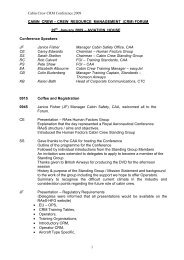Culture, Error, and Crew Resource Management - Human Factors ...
Culture, Error, and Crew Resource Management - Human Factors ...
Culture, Error, and Crew Resource Management - Human Factors ...
Create successful ePaper yourself
Turn your PDF publications into a flip-book with our unique Google optimized e-Paper software.
<strong>Culture</strong>, <strong>Error</strong>, <strong>and</strong> CRM 15<br />
fact that observers frequently see violations of SOPs <strong>and</strong> regulations. For example, as part of a line audit we<br />
observed instances of failure to complete (or even use) checklists. This was particularly prevalent in one fleet of one<br />
airline. Neither line checks nor Federal Aviation Administration inspections had suggested that this might be a<br />
problem. The line audit database gives clear guidance to management as to what to emphasize in training <strong>and</strong> also<br />
indicates where problems of leadership or poor safety norms may be present. Analyses of the aggregated, deidentified<br />
data from line audits give the industry insights into ubiquitous problems such as the use of flightdeck<br />
automation, the variability of performance in the system, <strong>and</strong> st<strong>and</strong>ardization of procedures <strong>and</strong> practices (Helmreich<br />
& Merritt, 1998; Helmreich, Hines, & Wilhelm, 1996; Hines, 1998).<br />
Confidential surveys<br />
Organizations can augment line audit data with confidential surveys, often using an instrument such as the<br />
Flight <strong>Management</strong> Attitudes Questionnaire (FMAQ: Merritt, Helmreich, Wilhelm, & Sherman, 1996). Surveys<br />
provide insights into perceptions of the safety culture <strong>and</strong> illuminate aspects of teamwork among flight crews <strong>and</strong><br />
other organizational elements including maintenance, ramp, <strong>and</strong> cabin. At the most detailed level, survey data also<br />
indicate the level of acceptance of fundamental concepts of CRM among line crews. They also show where<br />
differences may have developed between operational units of organizations, such as fleets <strong>and</strong> bases. Data from<br />
surveys can be used effectively to guide curriculum development for recurrent training by helping the organization<br />
target the most important operational issues.<br />
Incident reporting systems<br />
Incidents provide invaluable information about points of potential vulnerability in the aviation system.<br />
Confidential, incident reporting systems such as NASA’s Aviation Safety Reporting System <strong>and</strong> BASIS (British<br />
Airways Safety Information System) programs are very useful for the overall system. In the USA, the Aviation Safety<br />
Action Programs (ASAP, Federal Aviation Administration, 1997) concept was designed to give organizations more<br />
complete data on incidents in their own operations. ASAP encourages participation by providing crew members with<br />
protection from regulatory reprisal for many types of incidents <strong>and</strong> rapid feedback about organizational efforts to<br />
prevent their recurrence. Each reported incident is reviewed by a team (including representatives of management, the<br />
pilots’ union, <strong>and</strong> the FAA) which develops a plan of action along with feedback to the reporter. American Airlines<br />
has the longest experience with ASAP <strong>and</strong> is receiving reports at a rate of over 3,500 per year. As long as crews feel<br />
safe in submitting information to programs such as ASRS, BASIS, <strong>and</strong> ASAP, the data can give organizations an<br />
invaluable early warning system about potential threats to safety. Our research group, in cooperation with several<br />
U.S. airlines, has initiated a project to develop a new ASAP form to probe more deeply into human factors issues in<br />
incidents (Jones & Tesmer, in press). The object of this effort is to generate data that can be combined with those<br />
from other sources such as audits, surveys, <strong>and</strong> training records to provide organizations with a more comprehensive<br />
view of their operations <strong>and</strong> better guidelines for operations <strong>and</strong> training.<br />
We also recognize the value of data collected during normal operations from flight data recorders under<br />
programs such as the FAA’s Flight Operations Quality Assurance (FOQA). Such data provide critical information<br />
on the nature <strong>and</strong> location of instances where normal flight parameters are exceeded. A limitation of flight recorder<br />
data is that they provide no insight into why events occurred <strong>and</strong> the human factors issues associated with them. Line<br />
audits, confidential surveys, <strong>and</strong> incident reporting systems can augment FOQA programs <strong>and</strong> lead to a better<br />
underst<strong>and</strong>ing of causal factors.<br />
Using data proactively for safety<br />
The data collected in support of safety can be directly utilized in safety <strong>and</strong> error reduction initiatives. By<br />
examining the categories of error observed in their own observations, organizations obtain a valid report card on the<br />
effectiveness of their operation that different elements of the organization can use to plan necessary action. For<br />
example, a high frequency of operational decision errors may suggest a need for additional SOPs. Conversely, a large<br />
number of noncompliance errors may indicate inappropriate or too many <strong>and</strong> too complex SOPs (see also Reason,<br />
1997 for discussion of SOPs <strong>and</strong> compliance).




